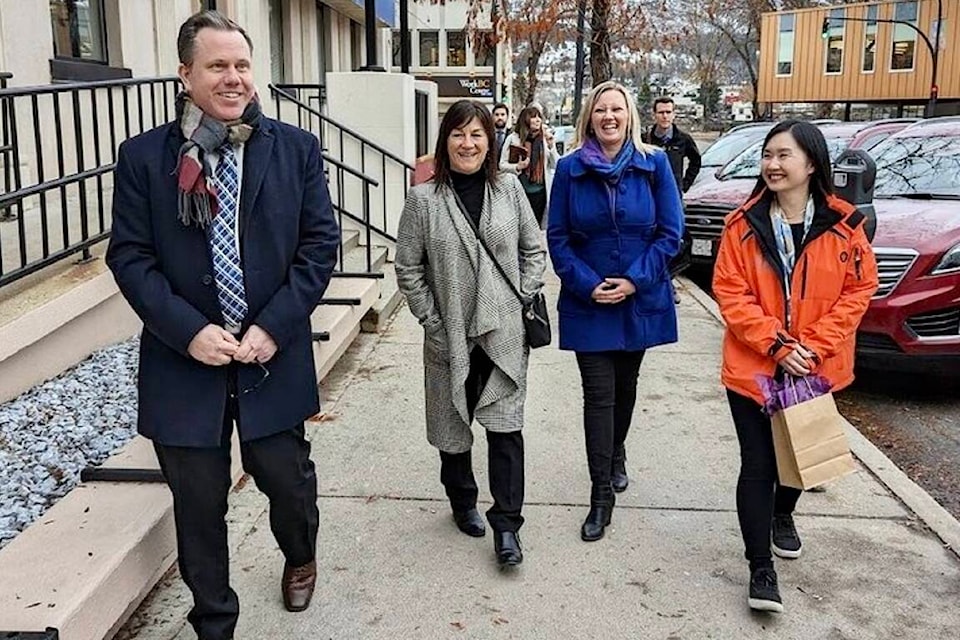Last week, Trail council toured the city with visiting Minister Anna Kang.
Kang heads the Ministry of Municipal Affairs, described as the branch of government that “takes leadership in supporting local governments and residents to build vibrant and healthy communities that are well governed, livable, safe, economically resilient, and socially and environmentally responsible.”
Council says they took the opportunity to express concerns over the lack of increased library funding, “despite the expectation of public libraries ramping up services and hours to accommodate increased homelessness, substance use, and extreme temperatures.”
As well, council says they voiced “community concerns of supportive housing shortages and the current location of the downtown shelter.”
“Council feels our concerns were heard,” Mayor Colleen Jones said. “Having the opportunity to show the minister our community was very important to council, and we are very thankful for her visit. Council looks forward to more discussions and keeping an open line of communication with the province.”
Since Kang’s visit brought the matter of the downtown shelter to the forefront once again, for an update on shelter use since last fall, the Trail Times contacted contract manager Sheila Adcock from Career Development Services. Adcock replied with such detailed insight, the story became a “Q and A.”
Trail Times (TT): First of all, can you tell us how many people access the shelter each night?
Adcock: We have, on average, about 20 guests that come in to sleep nightly as well as up to 15 coming in to get warm, have a light snack, use the washroom etc. Before the cold snap we, like all other shelters, had a cut off time at night for individuals to access a bed and were open just for sleeping with no drop-ins. We changed when the cold weather hit to accommodate those that may not want to sleep but need to come in to get warm and use the washroom.
TT: Can you give us a general idea of who is accessing the shelter?
Adcock: During the day we have drop-in services and have 40+ individuals dropping in for food, showers, toilet, clean/dry clothing etc. We have individuals of all ages ranging from 19 to 78 that have found themselves in a crisis situation and others that are struggling with ongoing chronic housing issues. The breakdown is approx 15 female and 25 males.
Individuals are struggling with a variety of issues which include, but are not limited to: mental health diagnosis; significant past and present trauma issues; breakdown in relationships and having to leave their home; discharged from the hospital with no way to get to their home outside of the Trail community; and dealing with substance use issues. Most of the individuals struggle with chronic homelessness and have been on the streets trying to survive for years which has led to significant health issues, involvement with the court system, and increased substance use issues in trying to cope with the stress.
There are a lot of barriers to accessing any treatment options and no safety plan when they have completed a treatment program. We see too often individuals that have completed a treatment program returning to the community and ending up right back where they started. And it wears them down over and over.
When we look at the information provided in our intake process, it is disturbing to see the increase in younger individuals accessing services.
A high number of the shelter guests indicate they had been involved with the foster care system in the past and there seems to be a gap in transitioning youth who have experienced trauma growing up, and have significant mental health issues.

TT: Can you tell us if there’s been success in finding the individuals more permanent housing? What is the main barrier to this?
Adcock: We have had success in returning individuals to their home communities where they either have housing or a support network, and we have assisted individuals to problem solve landlord/tenant issues in order to be able to maintain their housing.
There are many barriers to finding permanent housing; most individuals that are accessing services at the shelter are on assistance either regular benefits or PWD (persons with disabilities) which allows $375 for shelter. There is a housing crisis right now in this community, as in others, where rents have gotten so high they cannot afford to live.
The same apartment that was rented at $500 per month three years ago, is now renting for $1,200 to $1,500 per month.
No one can afford that.
The availability of rental units is very low which has driven the prices up so high that unless you have a two-income family, you cannot afford to rent anything. The assessed value of houses has increased so high that a lot of the long time landlords have opted to sell their rental property which has decreased the rental stock.
We have an employee — a single mother of three — that was a long term renter with a local landlord. The landlord decided to get out of the rental market and sell his house for three times the amount he purchased it for. This single mother struggled to find housing for her family but eventually secured a rental house, and is now paying $2,000 per month. This is an all too common story.
We have seniors and families coming in to try to get help through our Getting to Home Program with “renovictions” in hand that they have received from landlords that want to be able to get up to three times the current rent.
It is so bad that the B.C. landlord tenant branch is trying to step in saying that if a landlord wants to serve notice to a tenant to move out so they can renovate, the landlord needs to apply through them (tenant branch) so they can decrease the number of tenants being put on the streets.
The Getting to Home facilitator spends most of her time trying to assist individuals to access any rental subsidies they are eligible for so they can get a little bit of relief in order to survive.
TT: As the person who heads the frontline agency that actually works with vulnerable individuals — what is your hope in terms of finding a long term year-round shelter? Are you feeling hopeful? In your opinion, what barriers to relocating the shelter stand in the way?
Adcock: I am hoping that we can secure a supportive housing facility that will support the most vulnerable in our community. There have been some “affordable housing” options built in the community but they are not the option for those that need the extra on site support provided in a supportive housing option.
Individuals that have experienced chronic housing issues and mental health/substance use issues, will have staff on site (in supportive housing) to ensure they are safe and supported. There are many different supportive housing buildings in different communities and we have been working with BC Housing to identify what model would work best in this community.
The big issue is finding the property that will accommodate a building that would have approximately 40 units as well as an outdoor space and parking for staff and individuals.
Once the supportive housing option is available and long term shelter guests have relocated to the building, the need for a large long term shelter will decrease.
We will be working with BC Housing to look at options for the shelter to either be a stand-alone option or located in a section of the supportive housing building. They will work on what the most practical options are for this community based on the need, and include suggestions from local service providers in building any kind of plan for the space.
There is a long way to go before any supportive housing building can be built and be “move-in” ready. There are a lot of steps that have to happen.
The current shelter was set up to accommodate 10 to 12 individuals for the winter months.
It was never intended to support up to 40 individuals 24/7 ongoing year round.
There is no outdoor private space that individuals can use and no privacy inside due to having the beds set up in a big room where everyone sleeps, but are not available for sleeping during the day.
Expanding options to include the downstairs in the building has taken some of the stress off of the main floor, but still is not the optimal situation.
The plan is to relocate the shelter out of the downtown core where individuals accessing services feel like they have no privacy and sometimes feel like they are “monkeys in a zoo” with community members walking by, staring and making rude comments and threats, taking pictures etc.
The plan is once a site is confirmed, to set up temporary modules that will include double bedrooms, a kitchen and common area, washrooms, showers and laundry.
I believe this will be a better space that will allow for some privacy for the individuals accessing services, but I anticipate that no matter where it is located, there will be push back from the neighbours.
We will work with BC Housing and the city to ensure we are good neighbours and respectfully work to decrease the impact the shelter will have on the area.
TT: Is there anything in particular the shelter can use in terms of donations right now?
Adcock: Some things we are in short supply of are: single bed fitted sheets, we have to launder the bedding daily and do not use flat sheets; pillow cases; single bed comforters, we wash the bedding daily and cannot fit big double or queen comforters; socks, gloves, winter boots, jogging pants, and sweat shirts.
Career Development Services (CDS) is an agency governed by Trail Association for Community Living (TACL) since 2006. There are several ways to financially donate to the shelter or Getting to Home program, such as dropping off a cheque or cash at the CDS office, located at 1565 Bay Ave. To donate to a specific local program online, visit the TACL website: taclkootenays.com.
